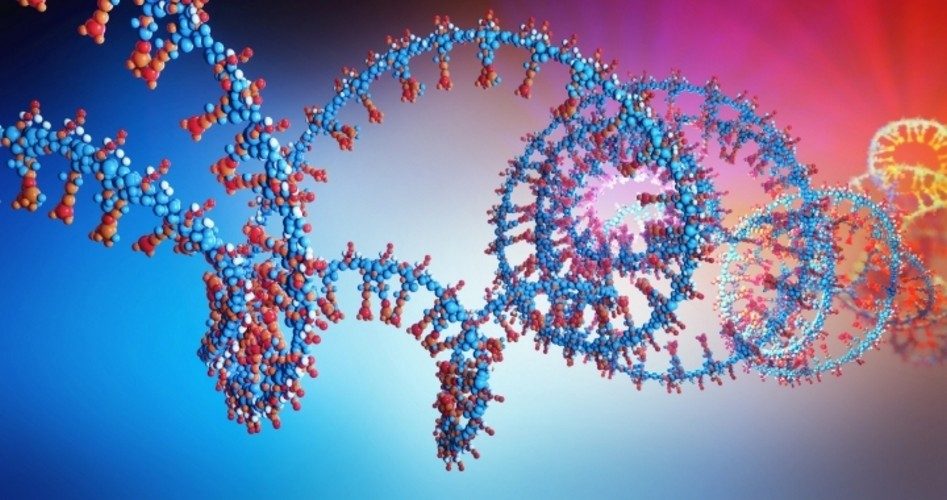
From the print edition of The New American:
Like all coronaviruses, and many others besides, SARS-CoV-2 is an RNA virus, meaning that its instruction set is encoded in a strand of ribonucleic acid rather than in the double helix of deoxyribonucleic acid (DNA). As a result, RNA viruses have a propensity for mutation.
Unlike DNA viruses that have more robust “proofreading” processes that limit mutation during replication, this is largely absent in RNA virus replication. The difference between RNA and DNA virus mutation was described by science journalist David Quammen in his 2012 book Spillover. DNA, he notes, is resistant to mutation by its double-stranded nature and because its chemical structure only bonds in specific ways. Additionally, during replication, DNA is “proofread” and repaired by the enzyme DNA polymerase. If a mistake is made during replication, Quammen notes, “the polymerase recognizes that mistake, backtracks … fixes the mismatch, and then moves on. So the rate of mutation in most DNA viruses is relatively low. RNA viruses, coded by a single-strand molecule with no such corrective arrangement … sustain rates of mutation that may be thousands of times higher.”
This property of RNA viruses has been known — and has worried scientists — for decades, with recognition of viral mutations coming as early as the 1940s. In 1987, D.A. Steinhauer and J.J. Holland of the Department of Biology at the University of California, San Diego, observed of RNA viruses, “Rates of evolution of continuously replicating RNA viruses may exceed by a million fold the rates of evolution of their DNA-based hosts.”
As a result of this rapid change, in 1988 James and Ellen Strauss from the Division of Biology at the California Institute of Technology noted that “RNA viruses will continue to evolve rapidly” and that “new pathogens can and will arise.”
{modulepos inner_text_ad}
Indeed, Steinhauer and Holland warned: “It should not be surprising that previously unknown human, domestic-animal, and plant crop diseases will appear at intervals, and that many or most will be due to evolving RNA genomes.”
Based on the propensity and likelihood of RNA virus mutation, it is likely, and certainly not surprising, that SARS-CoV-2 mutated within another species in such a way that it was able to jump to humans. And while it may or may not have happened in the Wuhan wet market, the potential exposure of a relatively large population of humans to concentrated potential animal source populations that were reportedly available in that market makes it a likely location for the jump to have occurred. And no release from the city’s biosafety level-4 lab would have been necessary.
SARS-CoV-2 Genome
In the case of the novel SARS virus, researchers in China were very quick in sequencing the new viral genome and in reporting the results of their research to the international scientific community. They published their findings in The Lancet. They found that the new virus was most similar to coronaviruses known to be endemic to bat populations.
Published online at the end of January, the Chinese researchers noted that SARS-CoV-2 “was more similar to two bat-derived coronavirus strains, bat-SL-CoVZC45 and bat-SL-CoVZXC21, than to known human-infecting coronaviruses, including the virus that caused the SARS outbreak of 2003.”
By publishing their work in The Lancet, the researchers made the rest of the world’s scientific establishment take note. And with the proliferation of the virus around the world, it would be possible to compare samples of the virus with the genome results from China. If the virus was an engineered bioweapon, that fact couldn’t stay hidden for long.
In fact, researchers with The Scripps Research Institute, along with researchers at Columbia University, the University of Edinburgh, the University of Sydney, and Tulane University, have concluded that the virus was not man-made. They found that both certain mutations to the receptor-binding domain (RBD) of the virus and its basic structural makeup prove that the virus developed from a natural, rather than laboratory-made, source.
In a press release, Scripps reported the researchers’ findings: “If someone were seeking to engineer a new coronavirus as a pathogen, they would have constructed it from the backbone of a virus known to cause illness. But the scientists found that the SARS-CoV-2 backbone differed substantially from those of already known coronaviruses and mostly resembled related viruses found in bats and pangolins.”
As for the receptor-binding domain — a part of a protein that can bind, or attach to, other molecules — the researchers found that while it had a high affinity for a certain human receptor (ACE2), it wasn’t perfect and that the SARS-Cov-2 “RBD sequence is different from those shown in SARS-CoV to be optimal for receptor binding.” SARS-CoV is the coronavirus that sparked a disease outbreak from 2002-2004 beginning in China’s Guangdong province.
“These two features of the virus, the mutations in the RBD portion of the spike protein and its distinct backbone, rule out laboratory manipulation as a potential origin for SARS-CoV-2,” concluded Kristian G. Anderson of the Department of Immunology and Microbiology at The Scripps Research Institute.
This article originally appeared in the April 20, 2020 “Freedom Is the Cure” special report of The New American. The New American publishes a print magazine twice a month, covering issues such as politics, money, foreign policy, environment, culture, and technology. To access the full report, as well as up-to-date reporting on COVID-19, click the ad below.
Image: Christoph Burgstedt/iStock/GettyImagesPlus

